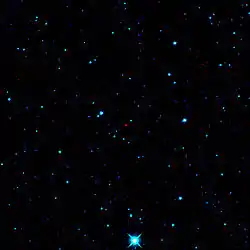(614599) 2010 AB78
(614599) 2010 AB78 is a dark asteroid on an eccentric orbit, classified as near-Earth object of the Amor group. It was first observed by the Wide-field Infrared Survey Explorer (WISE) on 12 January 2010.[1] The asteroid measures approximately 1.7 kilometers in diameter and has a low albedo of 0.03, which is rather typical for carbonaceous asteroids.[2]
 Stellar field obtained by WISE. The red dot in the center is 2010 AB78. | |
| Discovery[1] | |
|---|---|
| Discovered by | WISE |
| Discovery date | 12 January 2010 |
| Designations | |
| 2010 AB78 | |
| NEO · Amor[1][2] Mars-crosser | |
| Orbital characteristics[2] | |
| Epoch 4 September 2017 (JD 2458000.5) | |
| Uncertainty parameter 0 | |
| Observation arc | 9.97 yr (3,641 days) |
| Aphelion | 3.4872 AU |
| Perihelion | 1.0216 AU |
| 2.2544 AU | |
| Eccentricity | 0.5468 |
| 3.38 yr (1,236 days) | |
| 62.384° | |
| 0° 17m 28.32s / day | |
| Inclination | 33.253° |
| 316.93° | |
| 296.48° | |
| Earth MOID | 0.2058 AU (80.2 LD) |
| Mars MOID | 0.1206 AU (18,000,000 km)[1] |
| Physical characteristics | |
Mean diameter | 1.671±0.010 km[3] |
| 0.030±0.006[3] | |
| 18.3[2] | |
First WISE discovery
2010 AB78 is expected to become the first of the many thousands of discoveries to be accredited to the WISE space telescope.[4][5] However, the official discoverer will only be defined upon the asteroid's numbering.[1]
The first observation of 2010 AB78 by WISE was on January 12, 2010, being observed again the next day. The Mauna Kea Observatory observed it the days 18 and 19 of January, allowing the Minor Planet Center to publish a circular on January 22 confirming the discovery.[4]
Orbit
2010 AB78 orbits the Sun at a distance of 1.0–3.5 AU once every 3 years and 5 months (1,236 days). Its orbit has an eccentricity of 0.55 and an inclination of 33° with respect to the ecliptic.[2] Due to its eccentric orbit it is also a Mars-crosser. 2010 AB78 has the lowest possible orbital uncertainty, which may have caused it to be numbered.[2]
Close approaches
This near-Earth asteroid has a minimum orbital intersection distance with Earth of 0.2058 AU (30,800,000 km), which corresponds to 80.2 lunar distances.[2] It does not make any notable close approaches to Earth within the next hundred years.[2]
Physical characteristics
According to the survey carried out by the NEOWISE mission of NASA's discovering WISE observatory, 2010 AB78 measures 1.671 kilometers in diameter and its surface has an albedo of 0.030.[3] Objects known for such low albedos are the carbonaceous C, D and P-type asteroids.
As of 2018, no lightcurve has been obtained. The body's rotation period, shape and pole remain unknown.[2][6]
Numbering and naming
Up until 2021, this minor planet has not been named or numbered.[1] However it has since been numbered 614599 but is still yet to be named.[7]
References
- "2010 AB78". Minor Planet Center. Retrieved 17 August 2017.
- "JPL Small-Body Database Browser: (2010 AB78)" (2013-01-15 last obs.). Jet Propulsion Laboratory. Retrieved 17 August 2017.
- Mainzer, A.; Grav, T.; Bauer, J.; Masiero, J.; McMillan, R. S.; Cutri, R. M.; et al. (December 2011). "NEOWISE Observations of Near-Earth Objects: Preliminary Results". The Astrophysical Journal. 743 (2): 17. arXiv:1109.6400. Bibcode:2011ApJ...743..156M. doi:10.1088/0004-637X/743/2/156. S2CID 239991.
- Lakdawalla, Emily (22 January 2010). "WISE bags its first near-Earth object, 2010 AB78". The Planetary Society. Retrieved 3 February 2018.
- "The First Of Many Asteroid Finds For WISE". 25 January 2010. Retrieved 3 February 2018.
- "LCDB Data for (2010)". Asteroid Lightcurve Database (LCDB). Retrieved 3 February 2018.
- "Small-Body Database Lookup". ssd.jpl.nasa.gov. Retrieved 11 May 2022.
External links
- MPEC 2010-B33, Minor Planet Electronic Circulars, 22 January 2010
- (614599) 2010 AB78 at NeoDyS-2, Near Earth Objects—Dynamic Site
- (614599) 2010 AB78 at ESA–space situational awareness
- (614599) 2010 AB78 at the JPL Small-Body Database